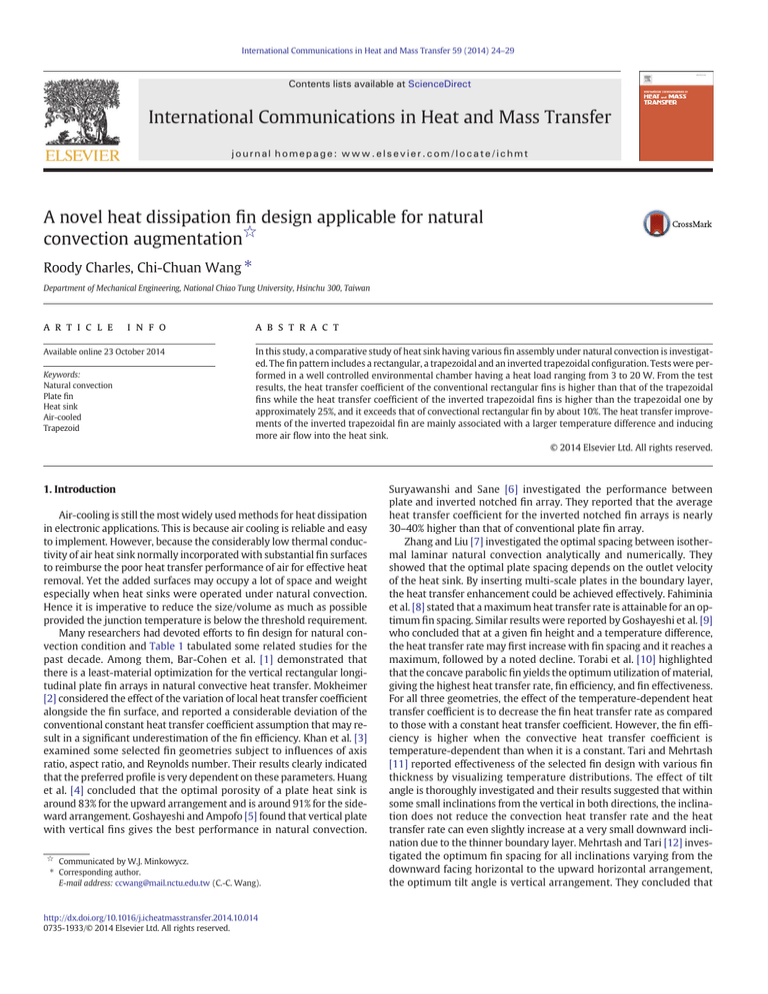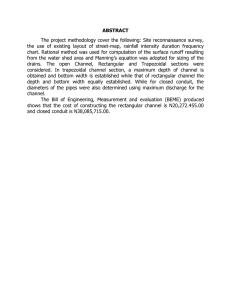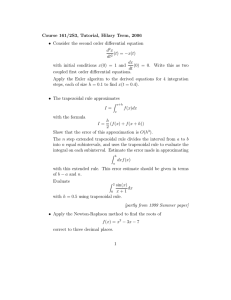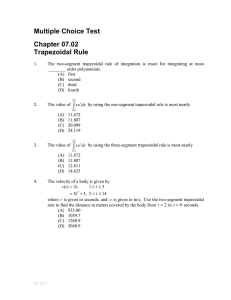
International Communications in Heat and Mass Transfer 59 (2014) 24–29
Contents lists available at ScienceDirect
International Communications in Heat and Mass Transfer
journal homepage: www.elsevier.com/locate/ichmt
A novel heat dissipation fin design applicable for natural
convection augmentation☆
Roody Charles, Chi-Chuan Wang ⁎
Department of Mechanical Engineering, National Chiao Tung University, Hsinchu 300, Taiwan
a r t i c l e
i n f o
Available online 23 October 2014
Keywords:
Natural convection
Plate fin
Heat sink
Air-cooled
Trapezoid
a b s t r a c t
In this study, a comparative study of heat sink having various fin assembly under natural convection is investigated. The fin pattern includes a rectangular, a trapezoidal and an inverted trapezoidal configuration. Tests were performed in a well controlled environmental chamber having a heat load ranging from 3 to 20 W. From the test
results, the heat transfer coefficient of the conventional rectangular fins is higher than that of the trapezoidal
fins while the heat transfer coefficient of the inverted trapezoidal fins is higher than the trapezoidal one by
approximately 25%, and it exceeds that of convectional rectangular fin by about 10%. The heat transfer improvements of the inverted trapezoidal fin are mainly associated with a larger temperature difference and inducing
more air flow into the heat sink.
© 2014 Elsevier Ltd. All rights reserved.
1. Introduction
Air-cooling is still the most widely used methods for heat dissipation
in electronic applications. This is because air cooling is reliable and easy
to implement. However, because the considerably low thermal conductivity of air heat sink normally incorporated with substantial fin surfaces
to reimburse the poor heat transfer performance of air for effective heat
removal. Yet the added surfaces may occupy a lot of space and weight
especially when heat sinks were operated under natural convection.
Hence it is imperative to reduce the size/volume as much as possible
provided the junction temperature is below the threshold requirement.
Many researchers had devoted efforts to fin design for natural convection condition and Table 1 tabulated some related studies for the
past decade. Among them, Bar-Cohen et al. [1] demonstrated that
there is a least-material optimization for the vertical rectangular longitudinal plate fin arrays in natural convective heat transfer. Mokheimer
[2] considered the effect of the variation of local heat transfer coefficient
alongside the fin surface, and reported a considerable deviation of the
conventional constant heat transfer coefficient assumption that may result in a significant underestimation of the fin efficiency. Khan et al. [3]
examined some selected fin geometries subject to influences of axis
ratio, aspect ratio, and Reynolds number. Their results clearly indicated
that the preferred profile is very dependent on these parameters. Huang
et al. [4] concluded that the optimal porosity of a plate heat sink is
around 83% for the upward arrangement and is around 91% for the sideward arrangement. Goshayeshi and Ampofo [5] found that vertical plate
with vertical fins gives the best performance in natural convection.
☆ Communicated by W.J. Minkowycz.
⁎ Corresponding author.
E-mail address: ccwang@mail.nctu.edu.tw (C.-C. Wang).
http://dx.doi.org/10.1016/j.icheatmasstransfer.2014.10.014
0735-1933/© 2014 Elsevier Ltd. All rights reserved.
Suryawanshi and Sane [6] investigated the performance between
plate and inverted notched fin array. They reported that the average
heat transfer coefficient for the inverted notched fin arrays is nearly
30–40% higher than that of conventional plate fin array.
Zhang and Liu [7] investigated the optimal spacing between isothermal laminar natural convection analytically and numerically. They
showed that the optimal plate spacing depends on the outlet velocity
of the heat sink. By inserting multi-scale plates in the boundary layer,
the heat transfer enhancement could be achieved effectively. Fahiminia
et al. [8] stated that a maximum heat transfer rate is attainable for an optimum fin spacing. Similar results were reported by Goshayeshi et al. [9]
who concluded that at a given fin height and a temperature difference,
the heat transfer rate may first increase with fin spacing and it reaches a
maximum, followed by a noted decline. Torabi et al. [10] highlighted
that the concave parabolic fin yields the optimum utilization of material,
giving the highest heat transfer rate, fin efficiency, and fin effectiveness.
For all three geometries, the effect of the temperature-dependent heat
transfer coefficient is to decrease the fin heat transfer rate as compared
to those with a constant heat transfer coefficient. However, the fin efficiency is higher when the convective heat transfer coefficient is
temperature-dependent than when it is a constant. Tari and Mehrtash
[11] reported effectiveness of the selected fin design with various fin
thickness by visualizing temperature distributions. The effect of tilt
angle is thoroughly investigated and their results suggested that within
some small inclinations from the vertical in both directions, the inclination does not reduce the convection heat transfer rate and the heat
transfer rate can even slightly increase at a very small downward inclination due to the thinner boundary layer. Mehrtash and Tari [12] investigated the optimum fin spacing for all inclinations varying from the
downward facing horizontal to the upward horizontal arrangement,
the optimum tilt angle is vertical arrangement. They concluded that
R. Charles, C.-C. Wang / International Communications in Heat and Mass Transfer 59 (2014) 24–29
Nomenclature
A
Ab
h
kb
k
Nu
Pr
Q
Ra
Tf
Ta
Tb & Tw
Ts
ΔT
x
θ
cross sectional area of the fins, m2
cross sectional area of the Bakelite, m2
heat transfer coefficient, W m−2 K−1
thermal conductivity of the Bakelite, W m−1 K−1
thermal conductivity of fluid, W m−1 K−1
Nusselt number, dimensionless
Prandtl number, dimensionless
Rate of heat transfer, W
Rayleigh number, dimensionless
fin temperature, °C
ambient temperature, °C
base plate temperature, °C
surface temperature of the heat sink, °C
effective temperature difference, °C
thickness of the Bakelite, m
inclined angle, degree
Subscripts
f
plate-fin
b
base
c
convection
i
input
t
total
l
loss
optimum fin spacing for the vertical orientation is most favorable. Tari
and Mehrtash [13] later investigated the previously uncovered inclination angle for the inclined cases and developed a set of correlations.
These correlations were shown to be very accurate in predicting heat
transfer rates using the available horizontal data from the literature.
Kim et al. [14] showed that the thermal resistance revealed an optimal
value at a specific fin number. However, the thermal resistance decreases continuously without reaching an optimal value as the fin
height is increased. Naserian et al. [15] concluded that by increasing
the fin number and the fin spacing, the ratio of natural convection
heat transfer coefficient of various fin configurations to the corresponding vertical plate is increased.
Based on the foregoing discussion, apparently the fin design casts
significant influences on the natural convection. Normally, the easiest
way is just to impose more surface area for effective reduction of thermal resistance. However, as aforementioned from previous studies,
the induced air flow under natural convection is normally quite restricted and can be significantly impaired by dense fin design, jeopardizing
the heat transfer accordingly. In this regard, the principal objective of
this study is to propose a novel fin design applicable for natural
convection.
2. Experimental setup
The designated concept of the fin pattern is simple. Instead of increasing the surface area, the basic idea is to increase the effective temperature difference, especially at the rear part of fin surface. Fig. 1
illustrates the proposed concept in association with the conventional
design. Fig. 1(a) is the convectional rectangular fin with identical
cross-sectional surface area at the fin base and fin tip, Fig. 1(b) is the
trapezoidal fin whose cross-sectional area at the fin base is larger than
that in the fin tip, and Fig. 1(c) is the proposed inverted trapezoid fin
in which the cross-sectional area at the fin tip is larger than that at the
fin base. Note that the effective surface areas amid these three designs
are the same, and their detailed dimensions are shown in Fig. 1(d). Experiments are performed in an environmental chamber whose volume
25
is 900 mm × 900 mm × 1240 mm. The environmental chamber can provide a temperature condition in the range of 20–50 °C with a controlled
resolution of 0.2 °C. In this study, the ambient temperature is fixed at
25 °C. To simulate the natural flow condition, the air ventilator is turned
off inside the test chamber when the ambient temperature reaches
25 °C. In particular, the air conditioner outside the test chamber continues to operate to maintain the room temperature at 25 °C. The test
facility is inside the test chamber which consists of a heat sink, a heater,
and insulation box, and a tilting mechanism as illustrated in Fig. 2(a).
The heat sinks are made of aluminum alloy 5083 with a thermal
conductivity 121 W m−1 K− 1. Five pin fin heat sinks are made via
CNC machining with a manufacturing precision of 0.03 mm. The heat
sinks are operated with the power inputs from 3 to 20 W. Detailed dimensions of the test samples are also shown in Fig. 1. A Kapton heater
with identical size as the base plate of the heat sink is used to eliminate
the spreading resistance. An insulation box made of bakelite with a low
thermal conductivity of 0.233 W m−1 K−1 is placed beneath the heater
to reduce the heat loss. In addition, a high thermal conductivity grease
(k = 2.1 W m−1 K−1) is used to connect the heat sink and the heater
for further minimization of the contact resistance. The heater is
powered by a DC power supply.
As seen in Fig. 2, a total of five T-type thermocouples which are
equally divided and located at beneath the base plate are used to obtain
the mean temperature of the base plate (Tb) of the heat sink. In addition,
a total of 10 T-type thermocouples are installed inside the insulation
box at two cross positions to calculate the heat loss from the bottom
of the Kapton heater. Each cross-section is equally instrumented with
five T-type thermocouples to obtain the mean temperature of that
cross section. The average temperature is then used to estimate the
heat loss via Fourier's law of conduction. The thermocouples were
pre-calibrated with an accuracy of 0.1 °C. The exact total heat transfer
rate by natural convection supply (Qt) is then obtained by subtracting
the estimated loss from the power input. The signals from thermocouples are then transmitted to a data acquisition system for further data
reductions. Usually, each test run needs approximate 2.5 h to reach
equilibrium when the power is turned on.
3. Data reduction
In the present study, the ambient air temperature is always controlled at 25 °C and the thermophysical properties are evaluated at
the film temperature, i.e.
T f ¼ 1=2ðTa þ Tb Þ:
ð1Þ
The actual heat transfer rate, Qt, is determined by subtraction the
heat loss Ql from the measured heat input Qi of the Kapton heater:
Qt ¼ Qi − Ql
Ql ¼
kb Ab ðTb −Ta Þ
:
x
ð2Þ
ð3Þ
The average heat coefficient can be calculated from the following:
h¼
Qt
:
AðTb −Ta Þ
ð4Þ
The experimental uncertainty is estimated using the uncertainty
propagation equation proposed by Kline and McClintock [16]. The maximum measured uncertainties of the heat transfer coefficient are about
11%, occurring at the lowest input power of 3 W. In particular, this uncertainty drastically decreases to less than 3% when the power input is
larger than 5 W.
26
R. Charles, C.-C. Wang / International Communications in Heat and Mass Transfer 59 (2014) 24–29
Table 1
Summary of the recent efforts of fin design subject to natural convection.
Authors
Year
Geometry
Orientation
Experimental/numerical
Range
Conclusion
Bar-Cohen
et al. [1]
2003
Rectangular fins
Vertical
Numerically
N/A
Mokheimer
[2]
2003
Horizontal
Experimentally
N/A
Khan et al.
[3]
2006
Straight and pin fin with
rectangular, convex
parabolic, triangular
and concave parabolic,
and radial fins
Circular, elliptical, square
and rectangular fins
Existence of a least-material
optimization for vertical rectangular
longitudinal plate fin.
The local heat transfer coefficient
as function of the local temperature.
Horizontal
Numerically
Nu = 0.75Re1/2Pr1/3
Huang et al.
[4]
2008
Flat and square pin fin
heat sinks
Upward, sideward
and downward
Experimentally
Ra ≤4 × 107
Goshayeshi and
Ampofo [5]
2009
Rectangular fins
Vertical &
horizontal
Numerically
N/A
Suryawanshi
and Sane [6]
2009
Rectangular fins
Horizontal
Experimentally &
numerically
Pr = 0.7
Zhang and Liu
[7]
2010
Rectangular fins
Vertical
Numerically &
analytically
Pr = 1
Fahiminia
et al. [8]
2011
Rectangular fins
Vertical
Numerically
Ra = 109
Goshayeshi
et al. [9]
2011
Rectangular fins
Vertical
Experimentally
Ra = 109
Torabi et al.
[10]
2013
Rectangular, trapezoidal
and concave parabolic
Horizontal
Numerically &
analytically
N/A
Tari and
mehrtash [11]
Mehrtash and
Tari [12]
2013
Rectangular fins
Rectangular fins
Numerically &
experimentally
Numerically &
experimentally
250 b GrPr b 104
2013
Inclined
±4° ≤ θ ≤ ±90°
Inclined
±4° ≤ θ ≤ ±90°
Tari and
Mehrtash [13]
2013
Rectangular fins
Slightly inclined:
θ = ±60° to ±90°
Experimentally &
numerically
N/A
Kim et al.
[14]
2013
Cylindrical heat sink
Horizontal
Experimentally
Ra = 300,000–1,000,000
Naserian et al.
[15]
2013
V-type fin
configurations
Vertical
Experimentally &
numerically
Nu = 0.59 (Ra)1/4
104 b Ra b 109
4. Results and discussion
This experimental result in terms of heat transfer coefficients for all
the test fin configurations, namely rectangular, trapezoidal and inverted
trapezoidal (so-called dovetail fin) is shown in Fig. 3. In order to simulate the heat sink of the different fin profiles for different inputs, the
experiment were carried out with various input powers of 3 W, 5 W,
10 W, 15 W and 20 W, respectively. As shown in Fig. 3, with the same
surface area, the heat transfer coefficient (HTC) for the proposed
inverted trapezoidal fin configuration appreciably outperforms those
of rectangular and trapezoidal designs. For a supplied heat flux of
600 W m−2, the HTC for inverted trapezoidal configuration is about
10% and 25% higher than that of rectangular and trapezoidal configuration, respectively. The difference prevails even when the heat flux
is less than 200 W m−2. The augmentation of the proposed inverted
0 b Ra b2 · 108
Temperature profile depends on
various parameters (e.g. Reynolds
number…).
The optimal heat sink porosity is
around 83% for the upward arrangement,
and 91% for the sideward arrangement.
Vertical plate with vertical fins
gives the best performance
for natural cooling.
The average heat transfer coefficient
for inverted notched fin arrays is
nearly 30–40% higher as compared
to normal array.
The heat transfer enhancement could be
conducted effectively and the intervals
of the multi-scale plates depend
on the height of the plates.
The convection rates increase with
increasing fin spacing and it reaches a
maximum at a certain fin spacing,
followed by a decline of heat
transfer rate.
At a given fin height and temperature
difference, the convection heat transfer
rates increase with increasing fin
spacing and reach a maximum.
The fin efficiency is higher when the
convective heat transfer coefficient is
temperature-dependent than when
it is a constant.
The inclination does not reduce the
convection heat transfer rate.
The optimum fin spacing for the vertical
orientation is obtainable for a certain
inclination of the heat sink.
The proposed correlations are
shown to be very accurate in
predicting heat transfer.
The thermal resistance has an
optimal value at a specific fin number.
However, the thermal
resistance decreases continuously
without reachingan optimal value
as the fin height increases.
An optimum fin shape occurs on a
vertical base arrangement.
trapezoidal fin configuration is mainly coming from making use of the
effective temperature difference ΔT. Note that the entrained air flow
primarily comes from the bottom of the two entrances of the heat
sink (fin gap). The air flow is heated up and flows toward the center
of the heat sink, yet it departs the heat sink upwardly. As expected,
the temperature difference amid the air flow and fin surface at the entrance is the largest and is reduced accordingly when the air flows toward the center of the heat sink, thereby leading to a tremendous
deterioration of heat transfer performance at the exit of the heat sink.
The results imply that the surface area near the exit of air flow is comparatively futile due to its lower temperature difference.
To tailor this problem, with the proposed inverted trapezoidal configuration, more fin surface was accommodated to have a larger temperature difference. This can be made clear from the inverted
protruded fin area at the entrance portion of the entrained air flow.
R. Charles, C.-C. Wang / International Communications in Heat and Mass Transfer 59 (2014) 24–29
(a) Rectangular fin
(b) Trapezoidal fin
27
(c) Inverted trapezoidal fin
(d) detailed dimension
Fig. 1. Rectangular fins, trapezoidal fins and inverted trapezoidal fins (with and without dimensions).
Secondly, the slightly lower fin height profile of the inverted trapezoidal
fin geometry also help to reduce the lower temperature difference portion at the exit of the air flow. In addition, the lower profile of inverted
fin geometry also contributes a smaller viscous drag of the airflow
across the fin pattern, thereby leading to a higher velocity. This can
also made clear from a numerical simulation carried out by a commercially available software — SolidWorks Flow Simulation with a grid
number of 5,963,636 cells. The trend of the calculated results is in line
with the measurements where the proposed inverted trapezoidal configuration outperforms rectangular and trapezoidal configuration by approximately 10% and 25%, respectively as also depicted in Fig. 3. The
simulation is carried out by omission of radiation contribution, hence
the calculated HTCs are smaller than those of measurements but the
trend of the calculations is analogous to the measurements. Moreover,
note that the induced maximum air flow velocity at the exit of fin
array from the numerical simulation for the inverted trapezoidal, rectangular, and trapezoidal fin geometry is 0.071, 0.06, and 0.05 m s−1, respectively at a supplied heat flux of 600 W m−2. The calculated higher
velocity of the inverted trapezoidal configuration agrees with previous
inference. Hence, in summary of these three effects, with an appreciable
rise of effective temperature difference and a moderate rise of entrained
air flow may bring about a higher heat transfer coefficient of the
inverted trapezoidal configuration. However, it should be emphasized
that the present inverted trapezoidal configuration may slightly offset
the effective fin efficiency if the protrusion part is too much.
5. Conclusion
The heat transfer coefficient characteristics of rectangular, trapezoidal and inverted trapezoidal pin fin heat sinks subject to horizontal arrangement are examined under natural convection in the present
study. The experimental results showed that the heat transfer coefficient (HTC) for the proposed inverted trapezoidal fin configuration appreciably outperforms those of rectangular and trapezoidal design. For a
supplied heat flux of 600 W m−2, the HTC for inverted trapezoidal configuration is about 10% and 25% higher than that of rectangular and trapezoidal configuration. The difference prevails even when the heat flux is
less than 200 W m−2. A numerical simulation for the three surfaces also
reveals a similar trend. The proposed inverted trapezoidal configuration
features a larger temperature difference at the entrance of the heat sink
and its slightly lower fin height profile also increases the temperature
difference at the exit of air flow. In the meantime, the lower profile of
inverted fin geometry also contributes to a smaller viscous drag of the
airflow across the fin pattern, thereby leading to a higher velocity. In
28
R. Charles, C.-C. Wang / International Communications in Heat and Mass Transfer 59 (2014) 24–29
Fig. 2. Schematic of the test facility and the Bakelite.
summary of these three effects bring about a much better heat transfer
characteristics of the inverted trapezoidal fin geometry.
Acknowledgements
The authors would like to thank for the support from the Ministry of
Science and Technology of Taiwan, under contract 103-3113-E-009002.
References
[1] A. Bar-Cohen, M. Lyengar, A.D. Kraus, Design of optimum plate-fin natural convective heat sinks, ASME J. Electron. Packag. 125 (2003) 208–216.
[2] E.M.A. Mokheimer, Heat transfer from extended surfaces subject to variable heat
transfer coefficient, Heat Mass Transf. 39 (2003) 131–138.
[3] W.A. Khan, J.R. Culham, M.M. Yovanovich, The role of fin geometry in heat sink performance, ASME J. Electron. Packag. 128 (2006) 324–330.
[4] R. Huang, W. Sheu, C.C. Wang, Orientation effect on natural convective performance
of square pin fin heat sinks, Int. J. Heat Mass Transf. 51 (2008) 2368–2376.
[5] H.R. Coshayeshi, F. Ampofo, heat transfer by natural convection from a vertical and horizontal surfaces using vertical fins, Energy Power Eng. 1 (2009)
85–89.
[6] S.D. Suryawanshi, N.K. Sane, Natural convection heat transfer from horizontal rectangular inverted notched fin arrays, ASME J. Heat Tran. 131 (2009) (082501-1082501-6).
[7] X. Zhang, D. Liu, Optimum geometric arrangement of vertical rectangular fin arrays
in natural convection, Energy Convers. Manag. 51 (2010) 2449–2456.
[8] M. Fahiminia, M.M. Naserian, H.R. Goshayeshi, D. Majidian, Investigation of natural
convection heat transfer coefficient on extended vertical base plates, Energy
Power Eng. 3 (2011) 174–180.
[9] H.R. Goshayeshi, M. Fahiminia, M.M. Naserian, Improvement of free convection heat
transfer of rectangular heat sink on vertical base plates, Energy Power Eng. 3 (2011)
525–532.
[10] M. Torabi, A. Aziz, K. Zhang, A comparative study of longitudinal fins of rectangular,
trapezoidal and concave parabolic profiles with multiple nonlinearities, Energy 51
(2013) 243–256.
[11] I. Tari, M. Mehrtash, Natural convection heat transfer from inclined plate-fin sinks,
Int. J. Heat Mass Transf. 56 (2013) 574–593.
R. Charles, C.-C. Wang / International Communications in Heat and Mass Transfer 59 (2014) 24–29
29
Variation of heat transfer coefficient with heat flux
(Experimental and computational data).
8
2
Heat transfer coefficient, W/m K
7
6
5
4
3
2
0
100
200
300
400
500
600
700
2
Heat flux, W/m
Rectangular fins (Experimental data)
Trapezoidal fins (Experimental data)
Inverted Trapezoidal fins(Experimental data)
Rectangular fins (Computational data)
Trapezoidal fins (Computational data)
Inverted Trapezoidal fins (Computational data)
Fig. 3. Performance of the heat transfer coefficient compared to the heat flux.
[12] M. Mehrtash, I. Tari, A correlation for natural convection heat transfer from inclined
plate-finned heat sinks, Appl. Therm. Eng. 51 (2013) 1067–1075.
[13] I. Tari, M. Mehrtash, Natural convection heat transfer from horizontal and slightly
inclined plate-fin heat sinks, Appl. Therm. Eng. 61 (2013) 728–736.
[14] H.J. Kim, B.H. An, J. Park, D. Kim, Experimental study on natural convection heat
transfer from horizontal cylinders with longitudinal plate fins, J. Mech. Sci. Technol.
27 (2013) 593–599.
[15] M.M. Naserian, M. Fahiminia, H.R. Goshayeshi, Experimental and numerical analysis
of natural convection heat transfer coefficient of V-type fin configurations, J. Mech.
Sci. Technol. 27 (2013) 2191–2197.
[16] S.J. Kline, F.A. McClintock, Describing uncertainties in single-sample experiments,
Mech. Eng. 75 (1953) 3–8.






